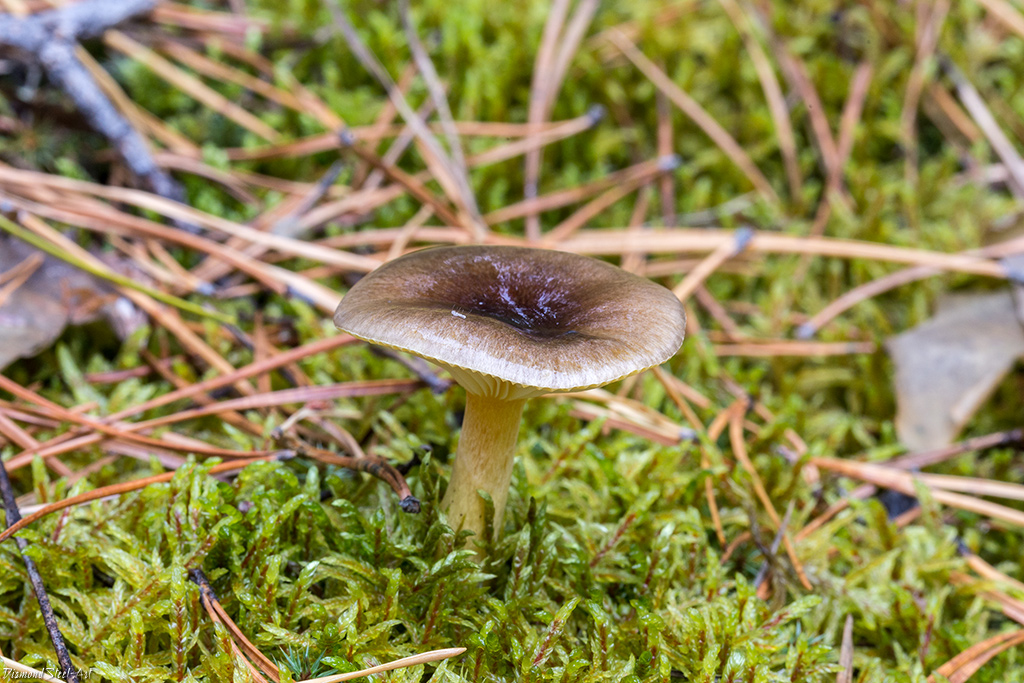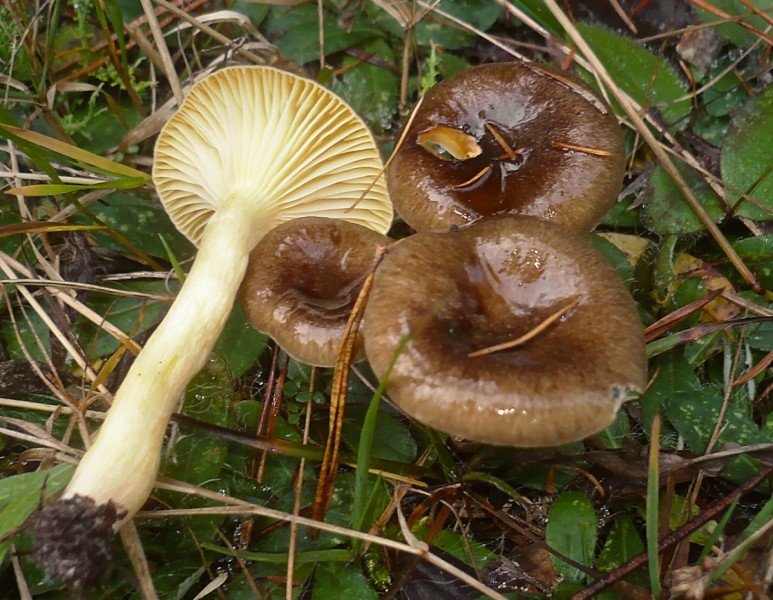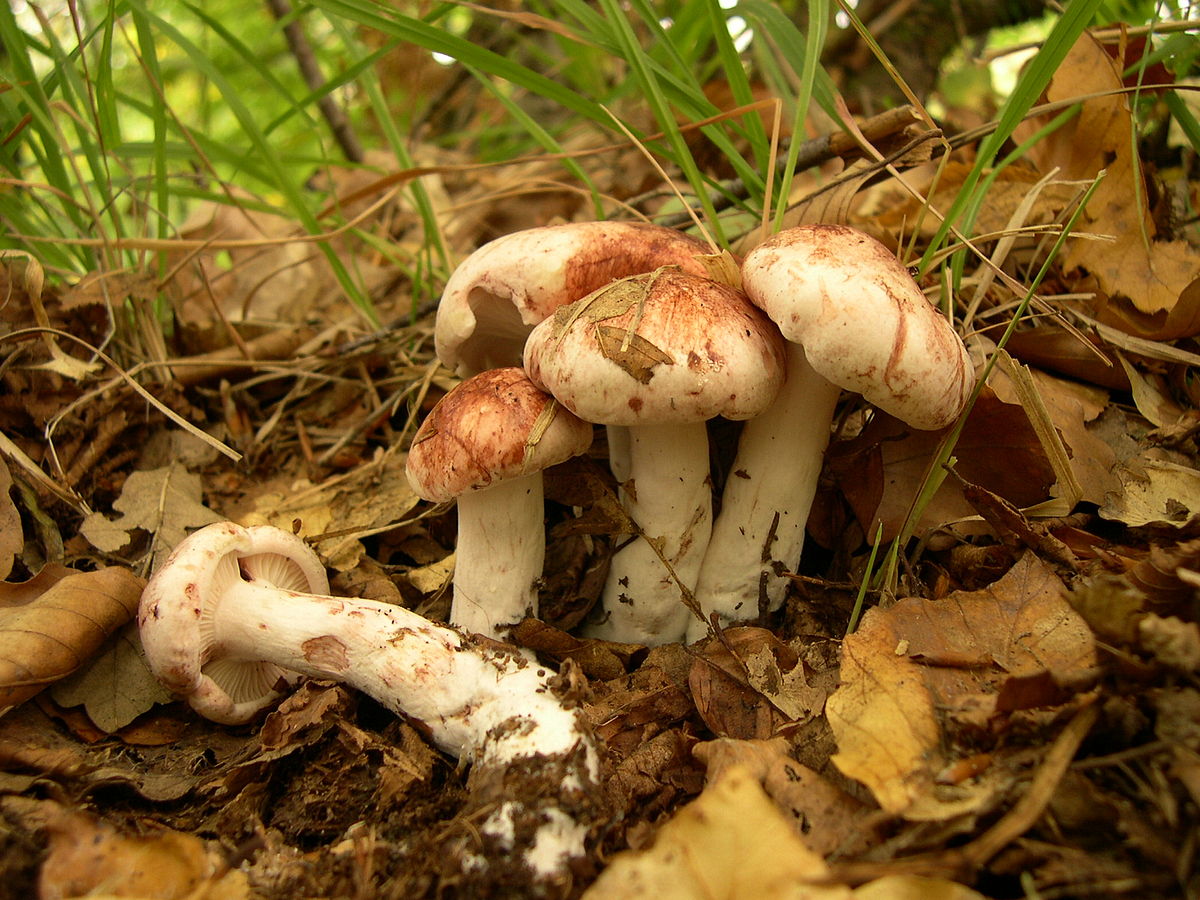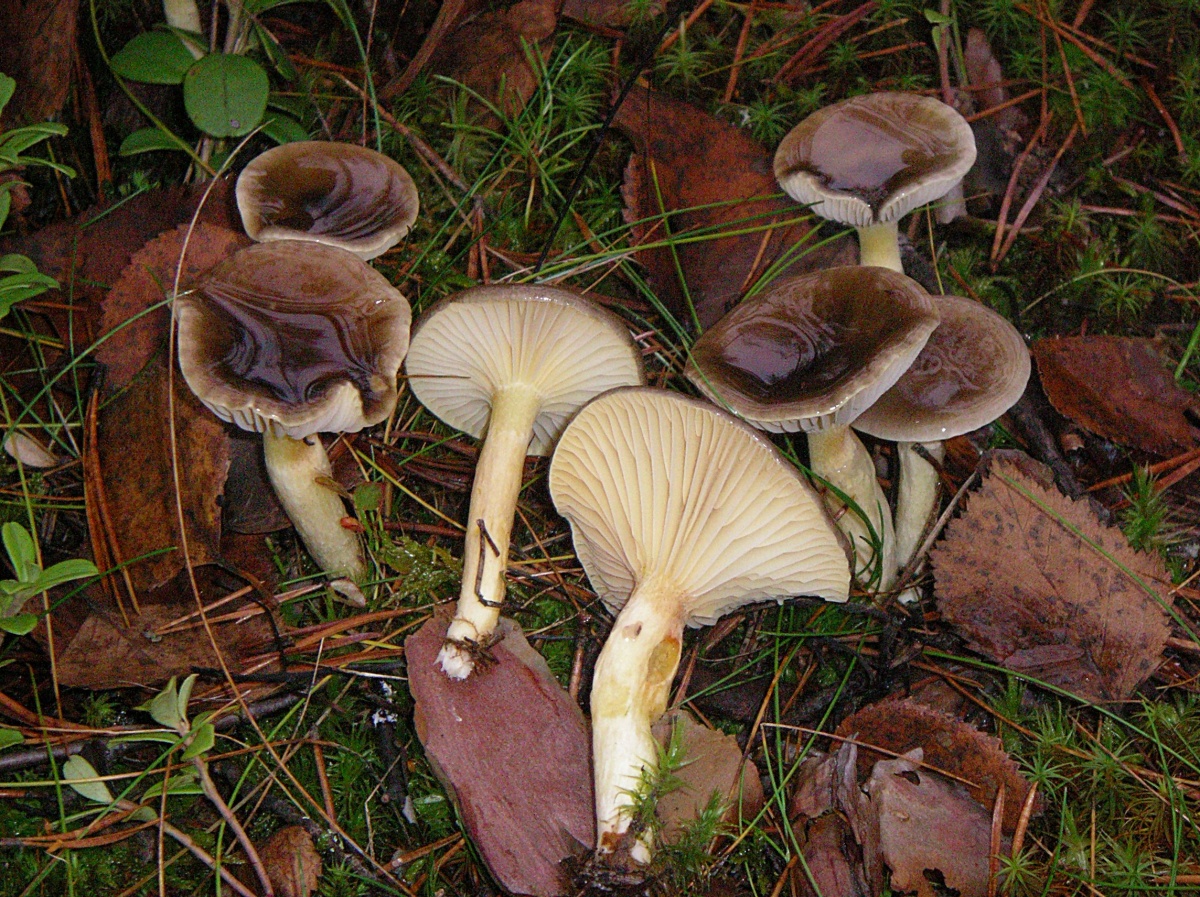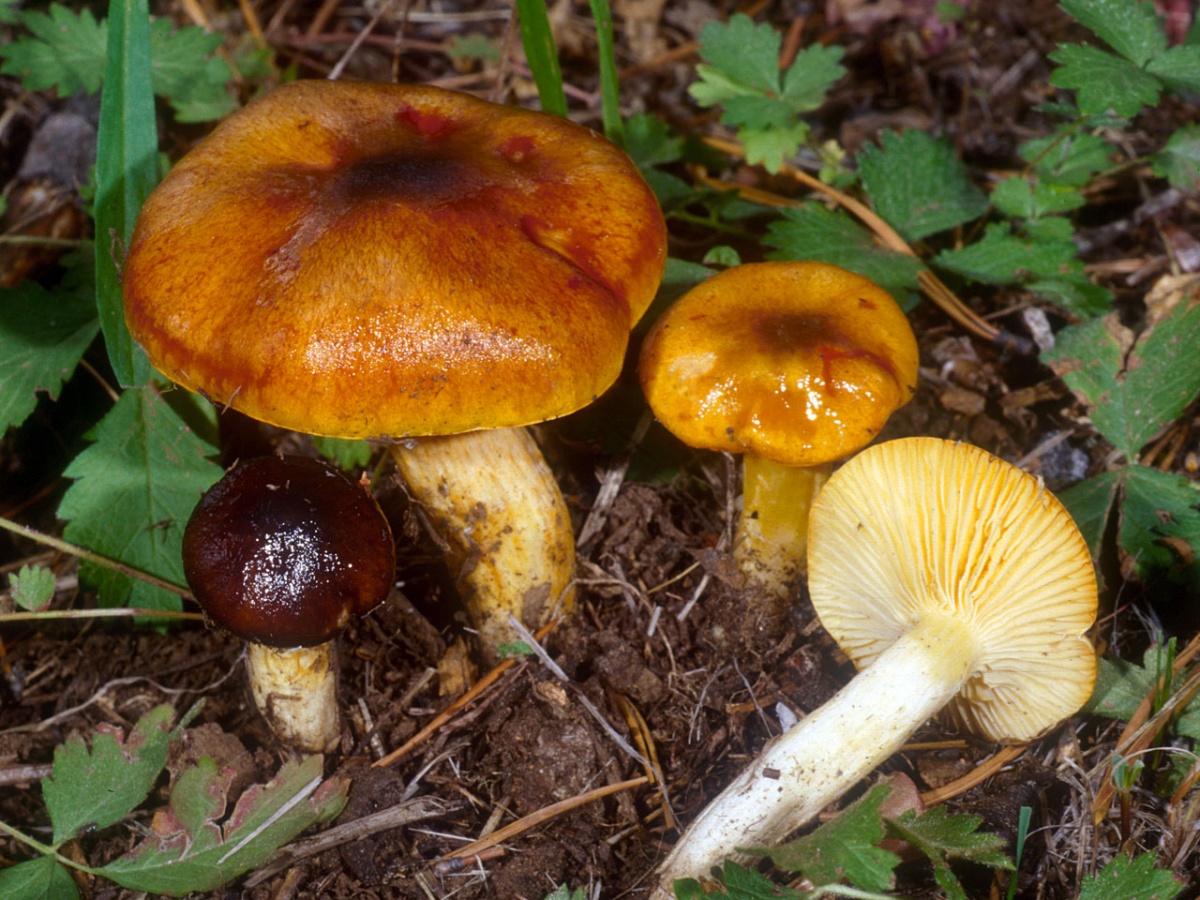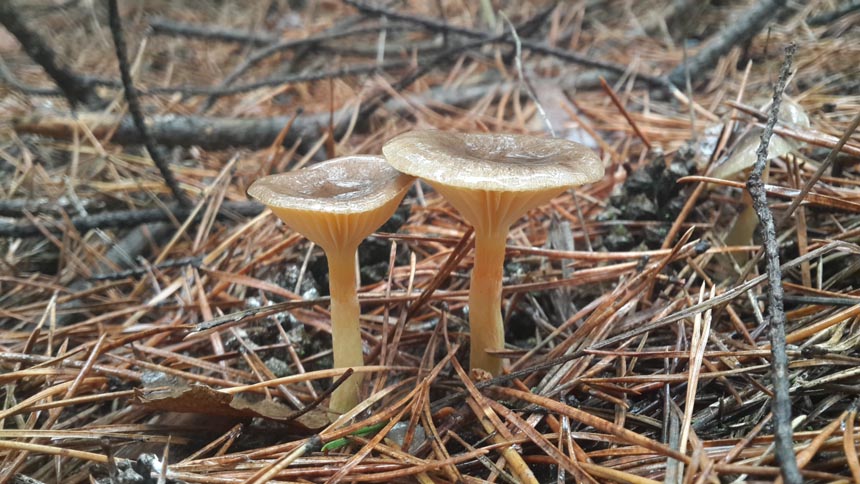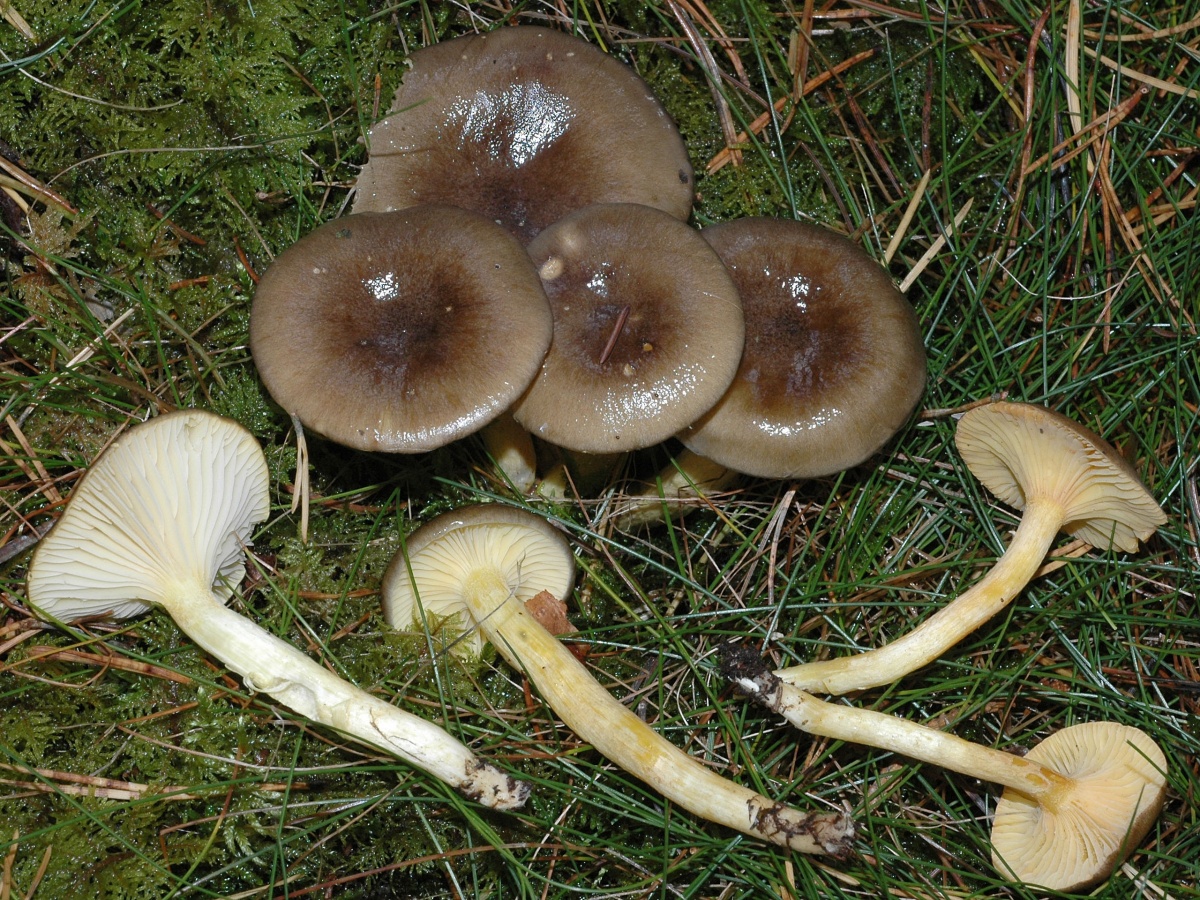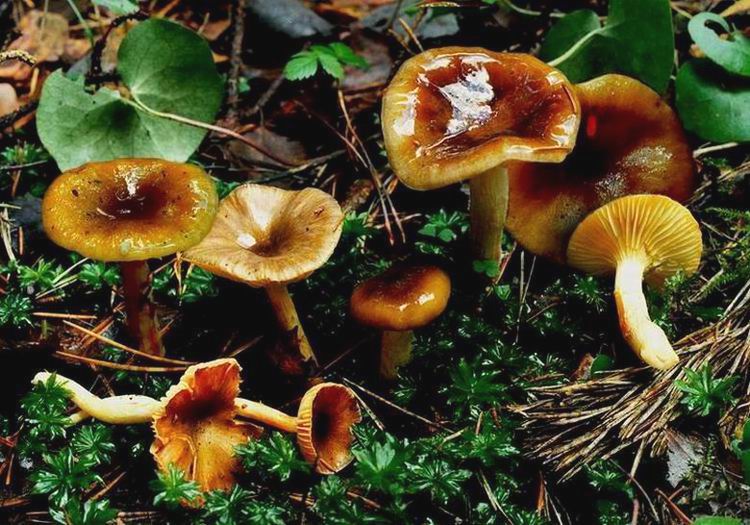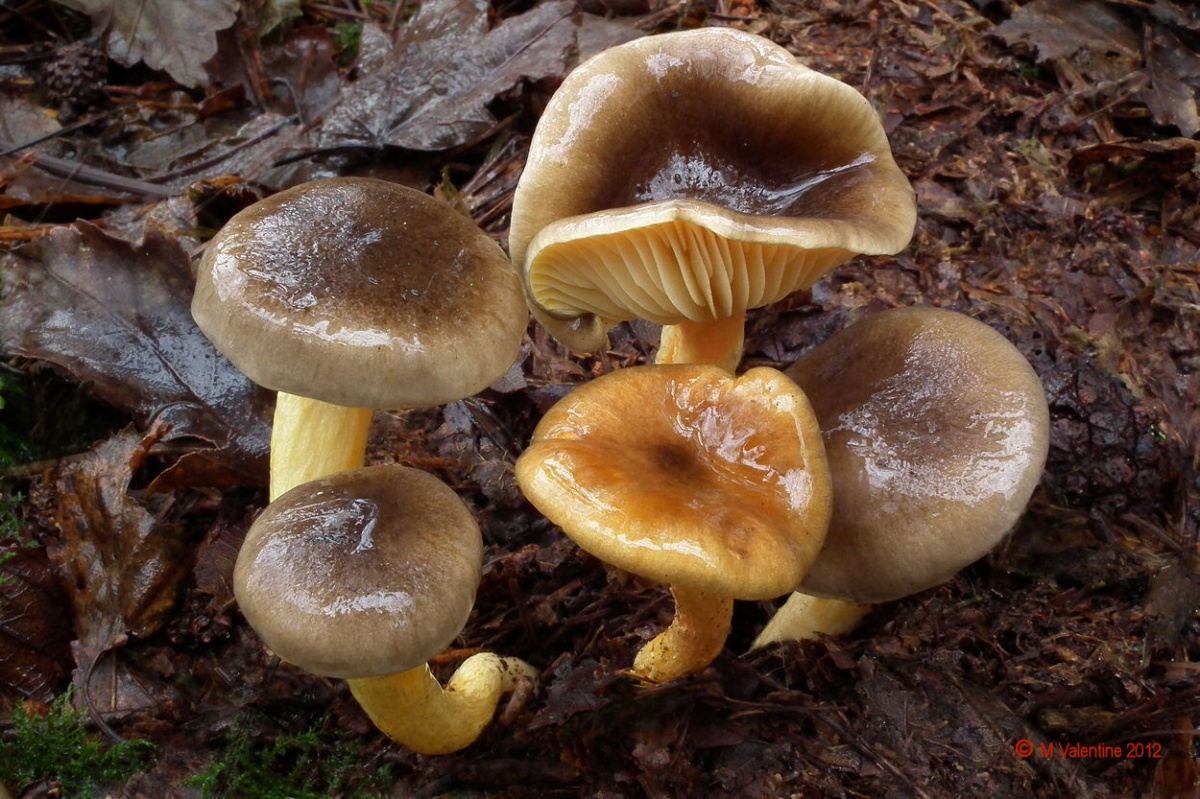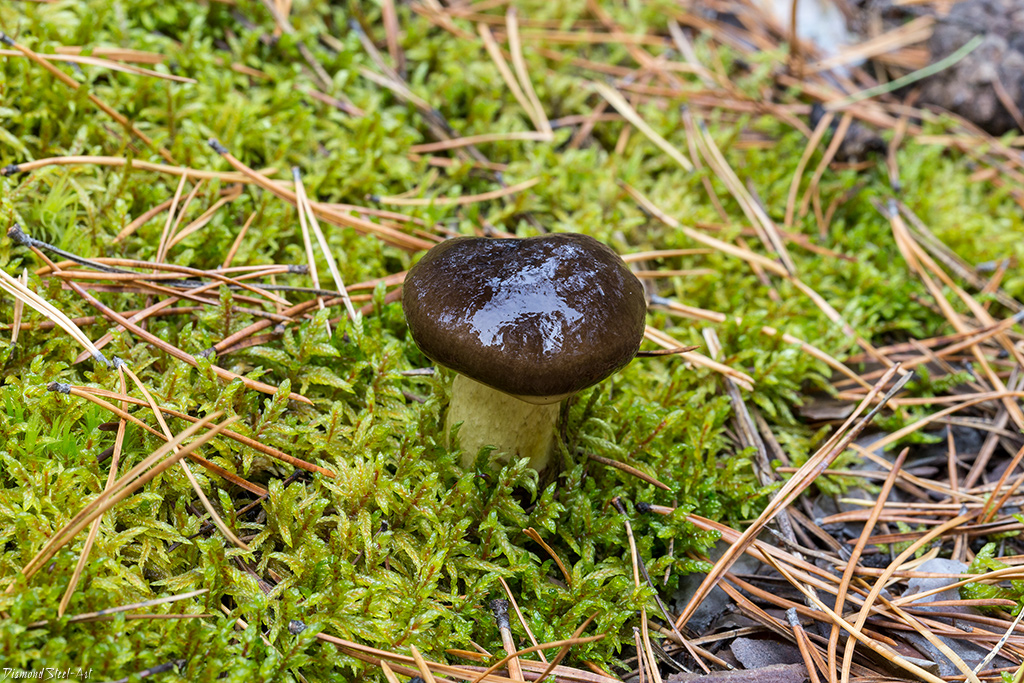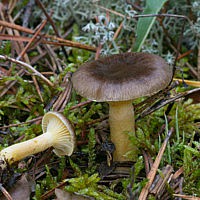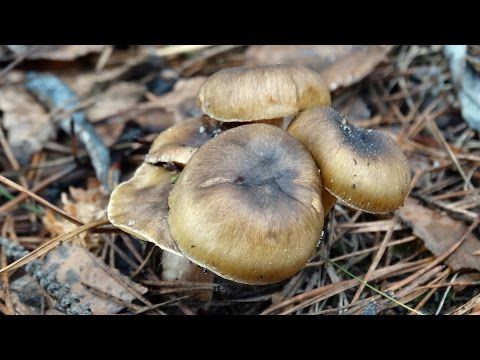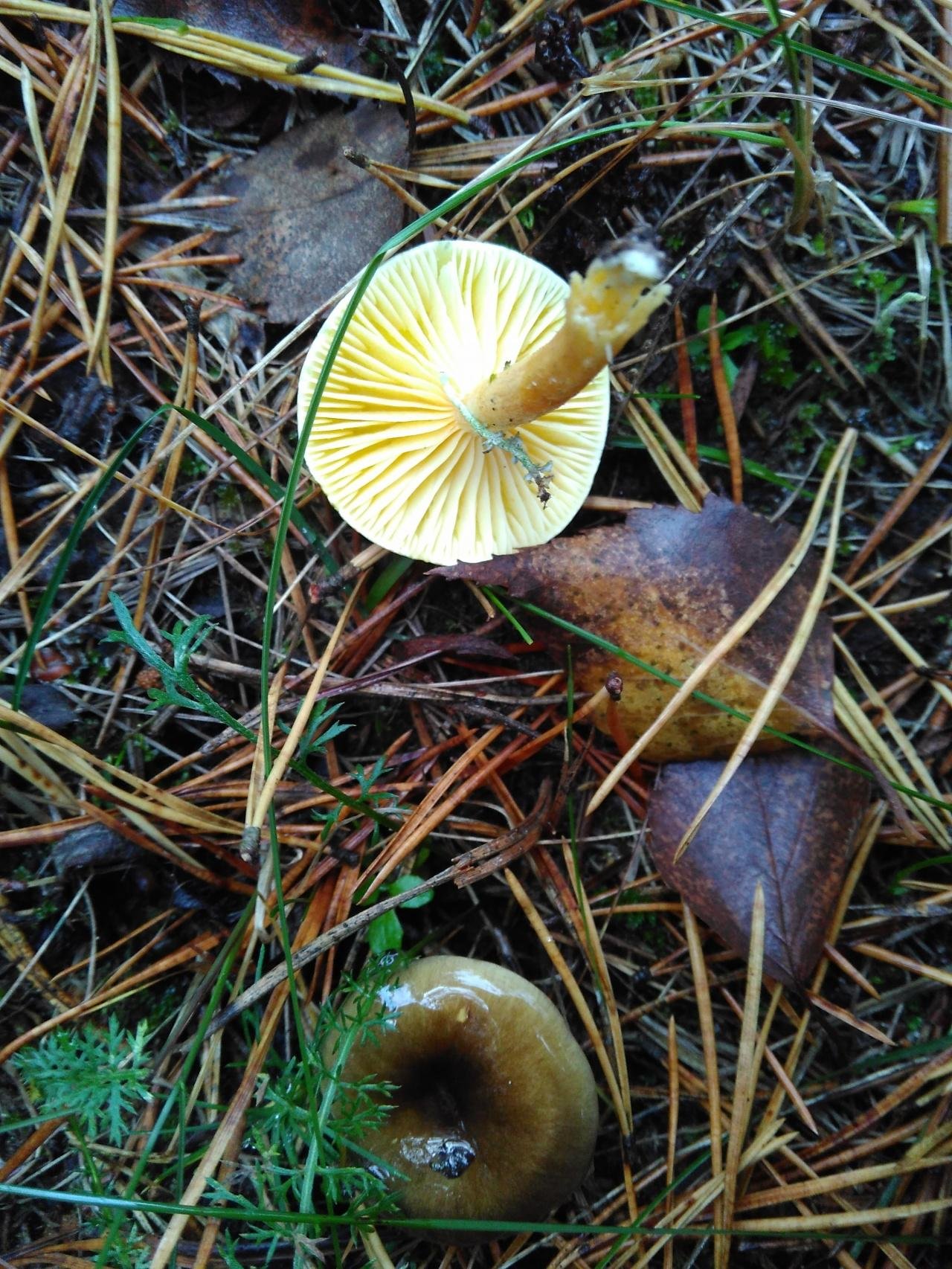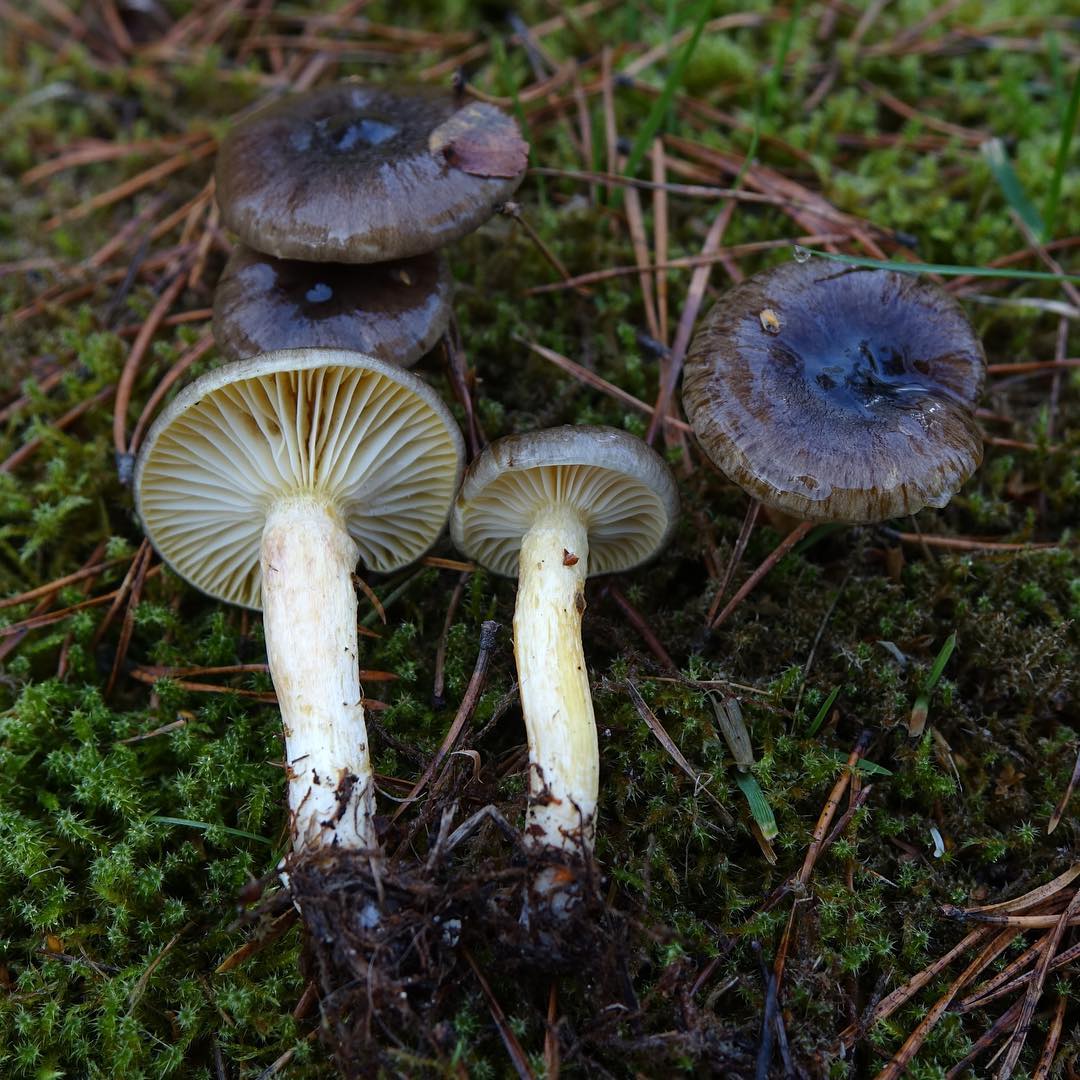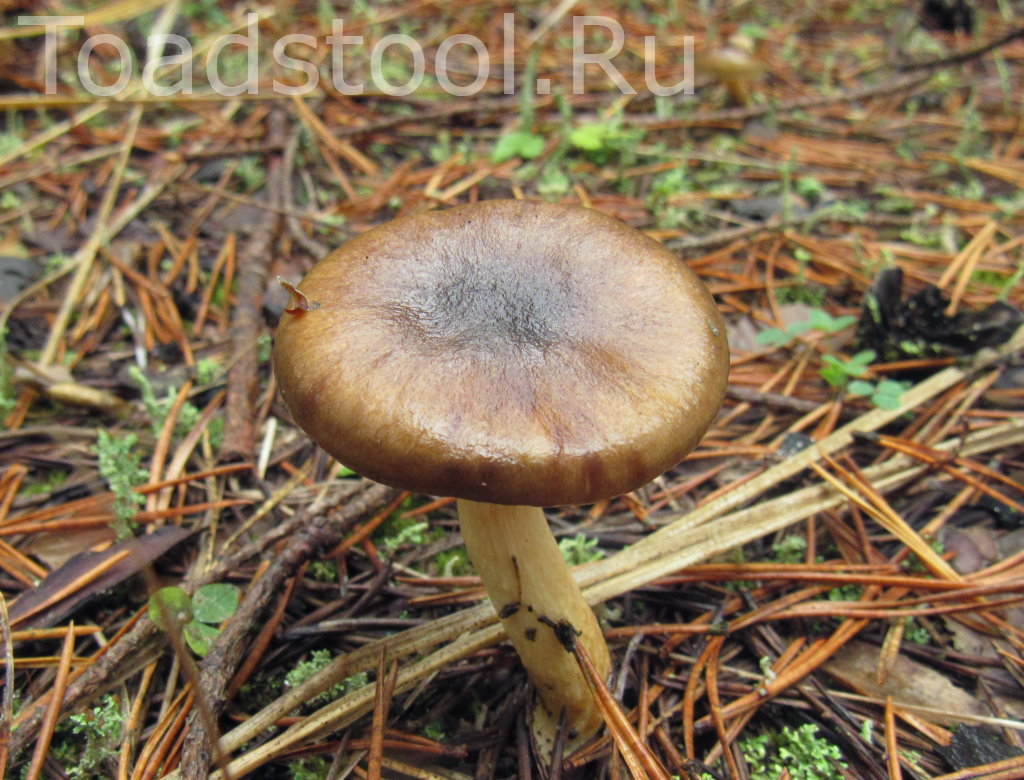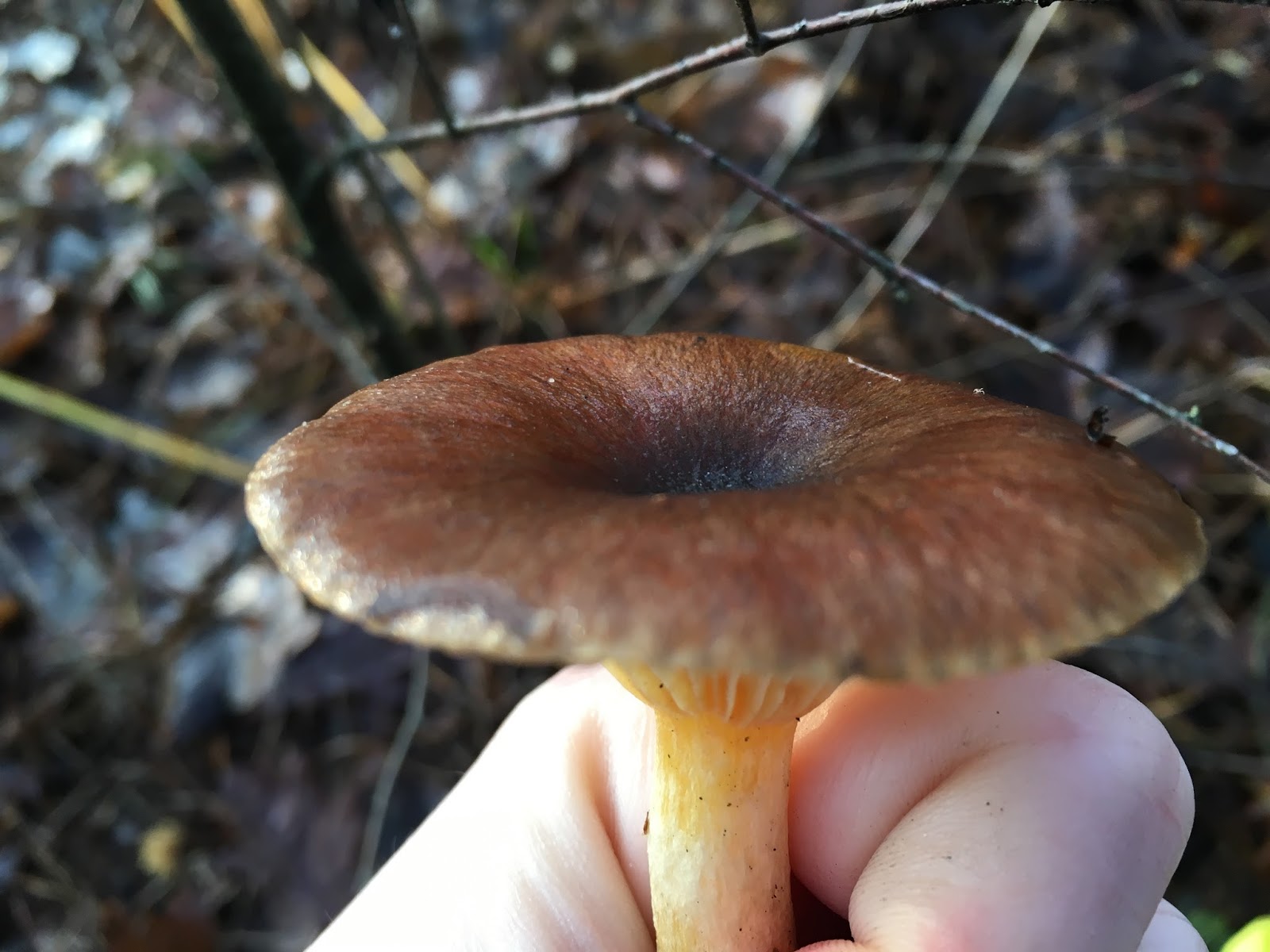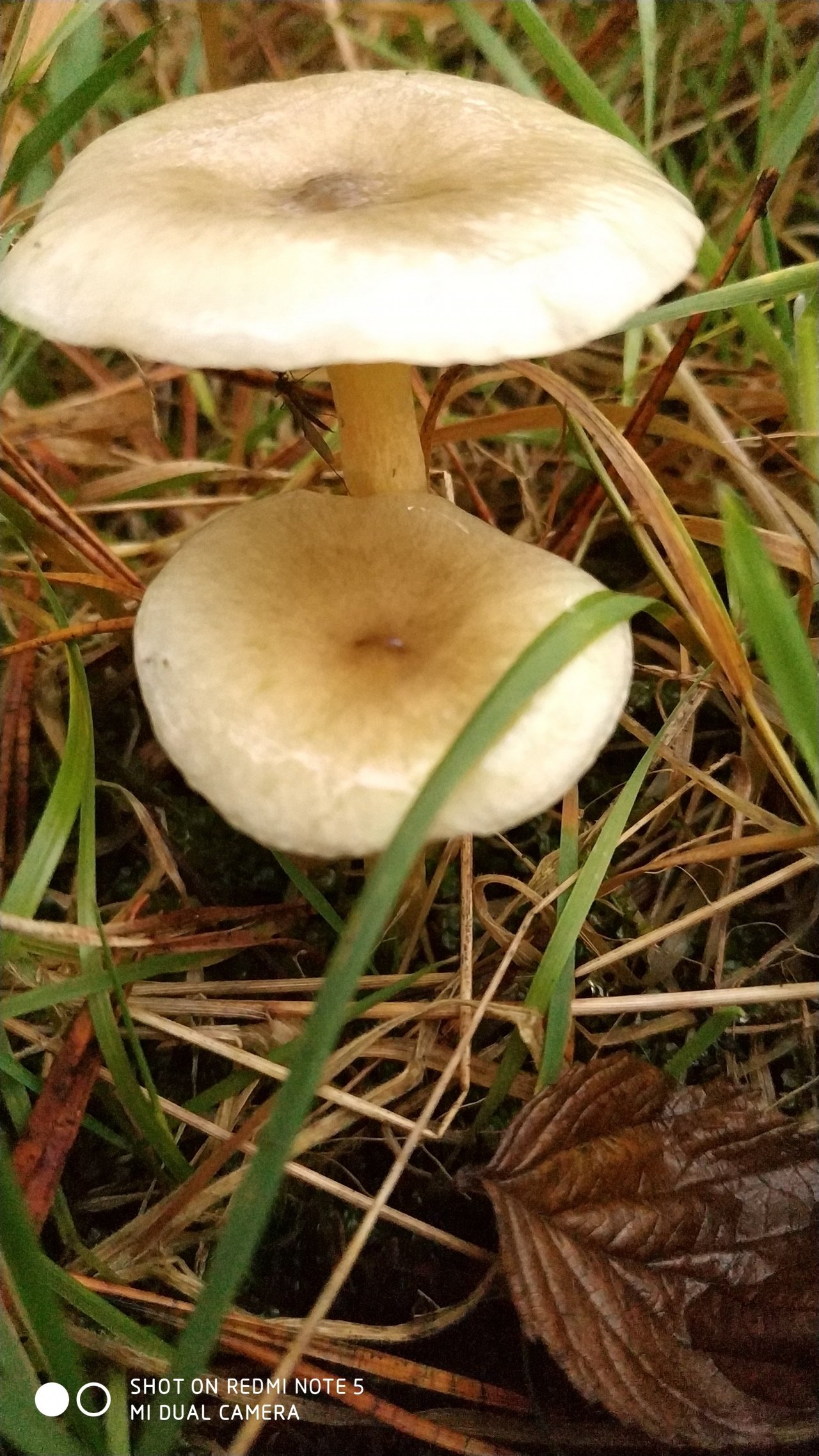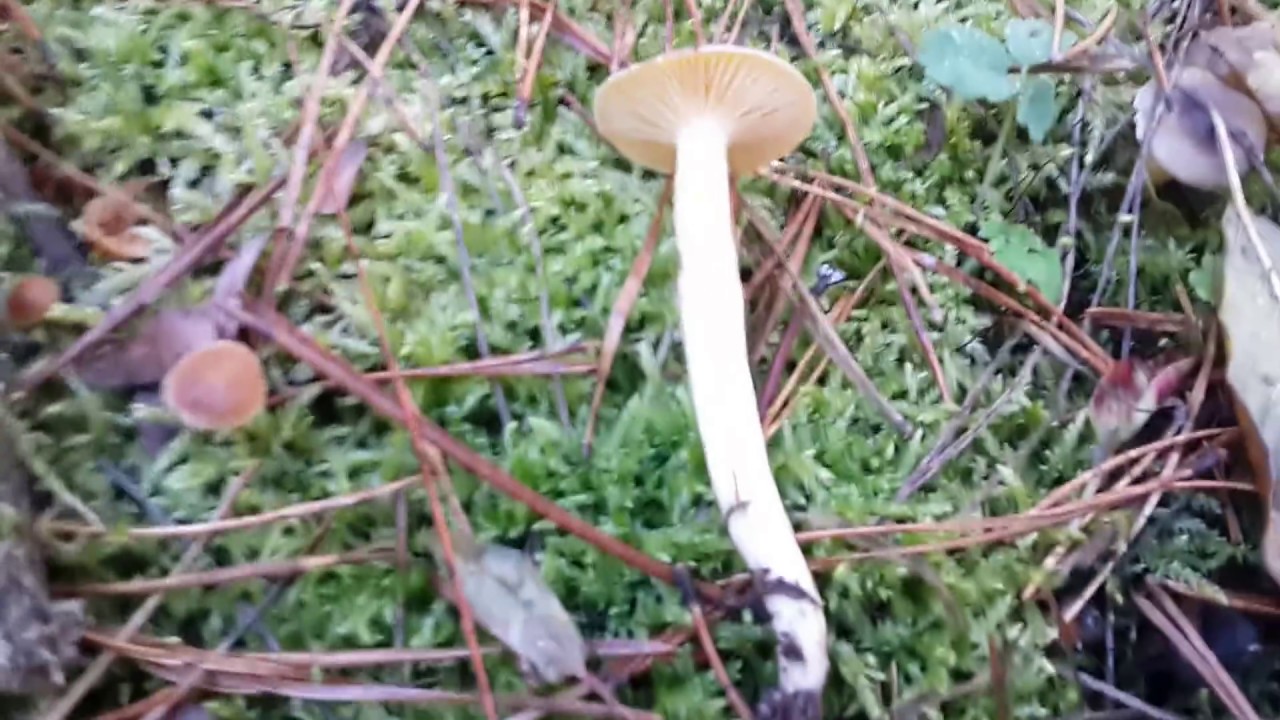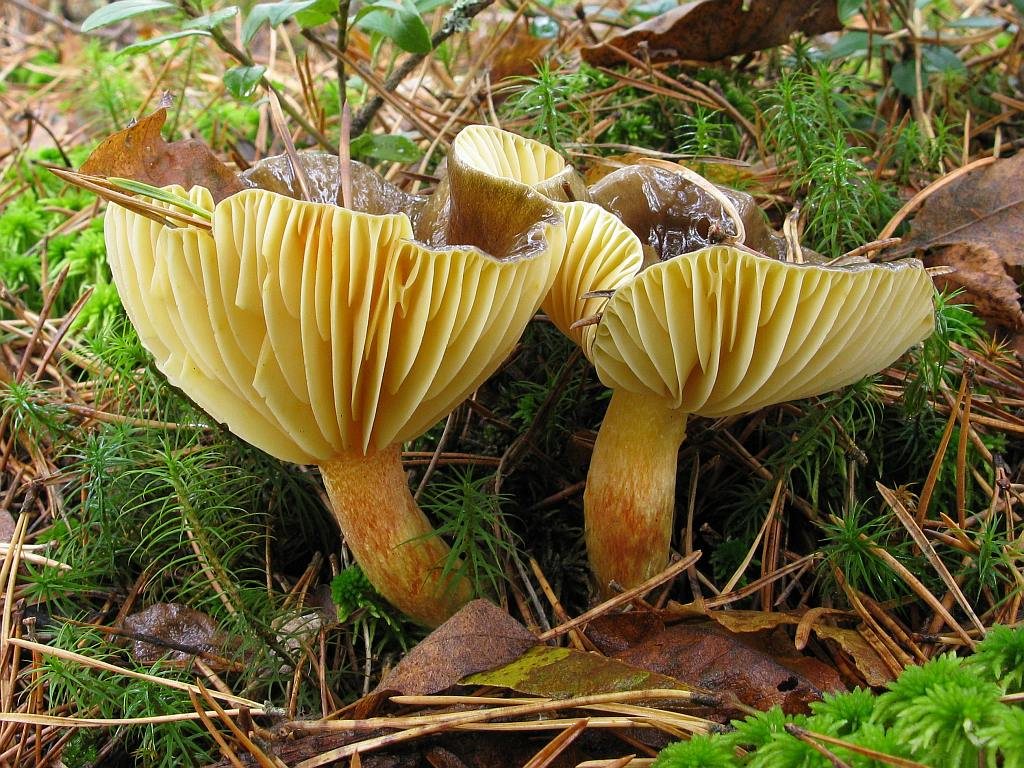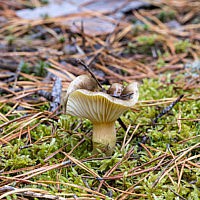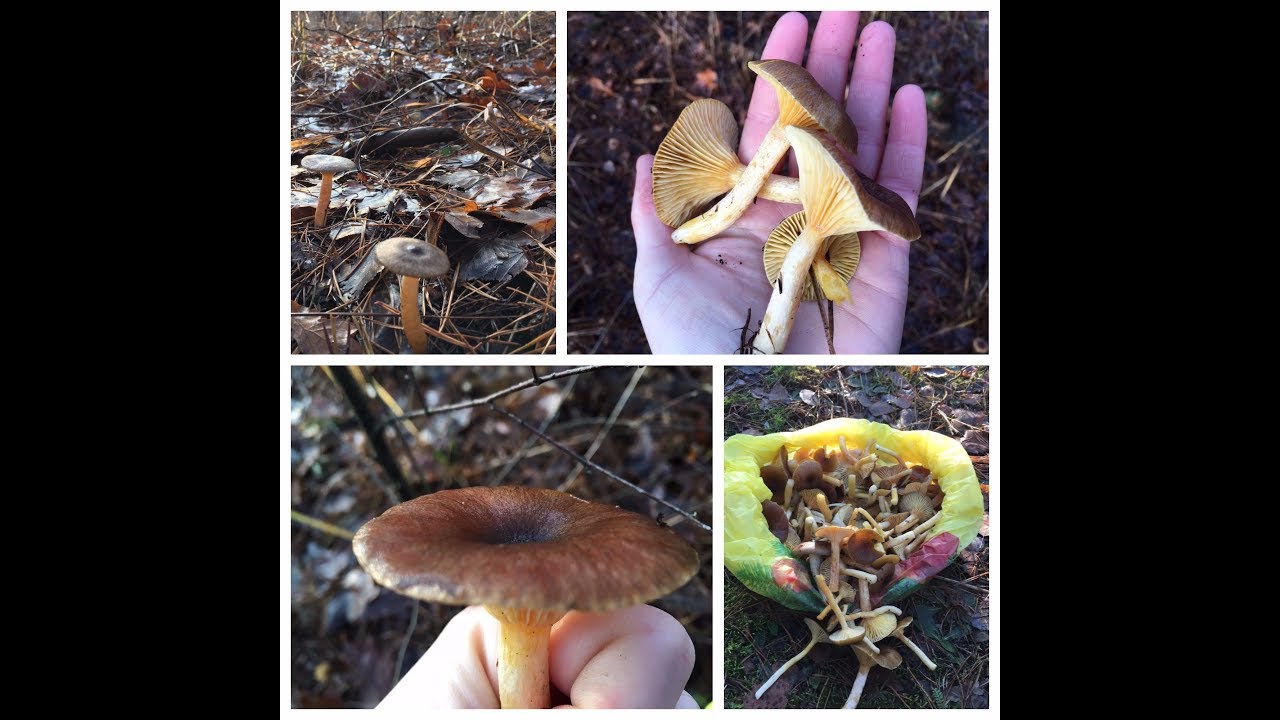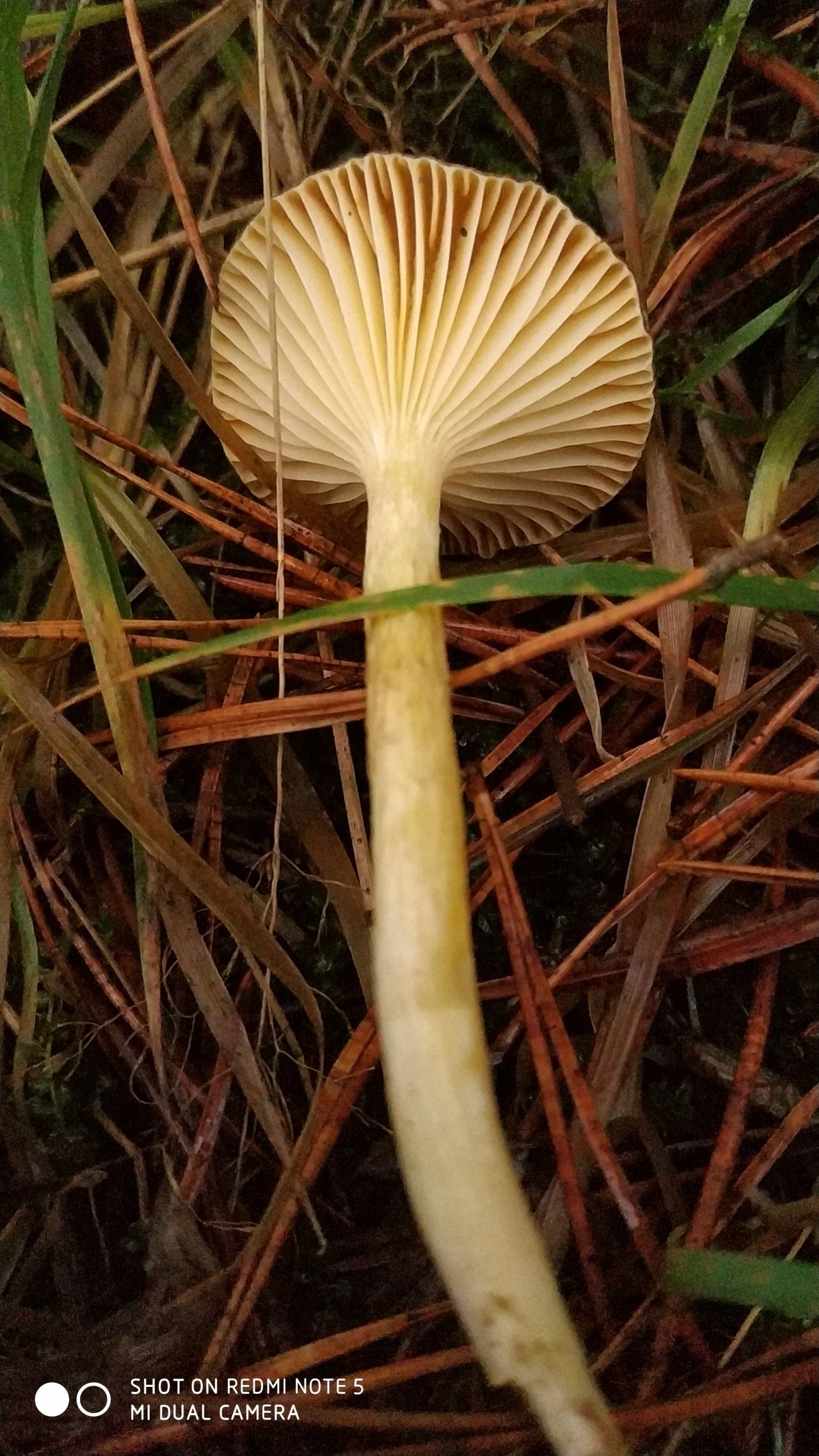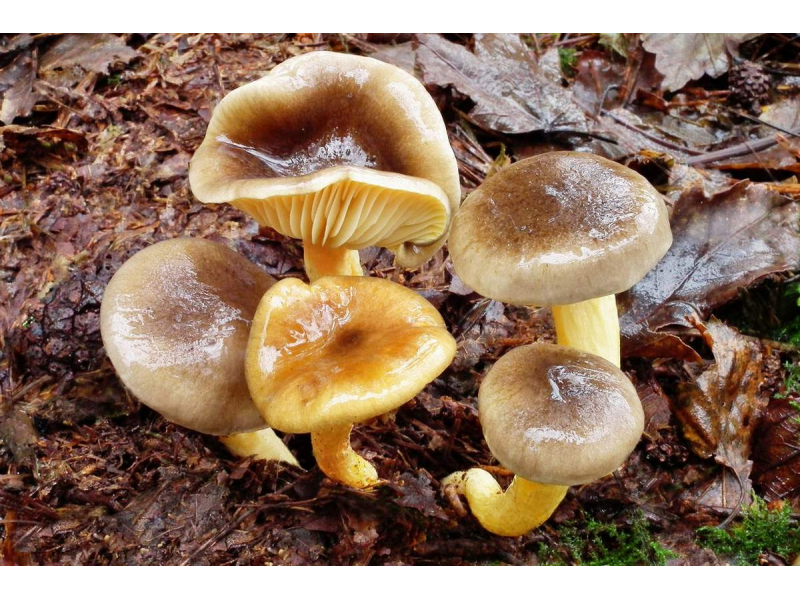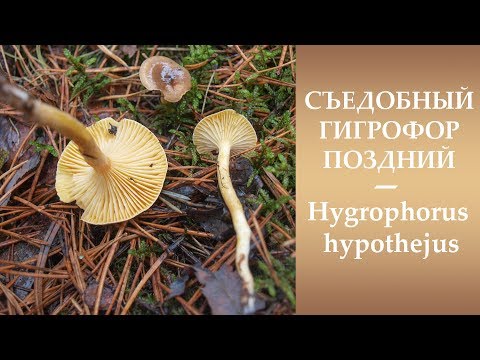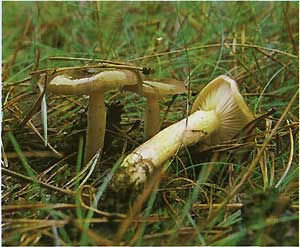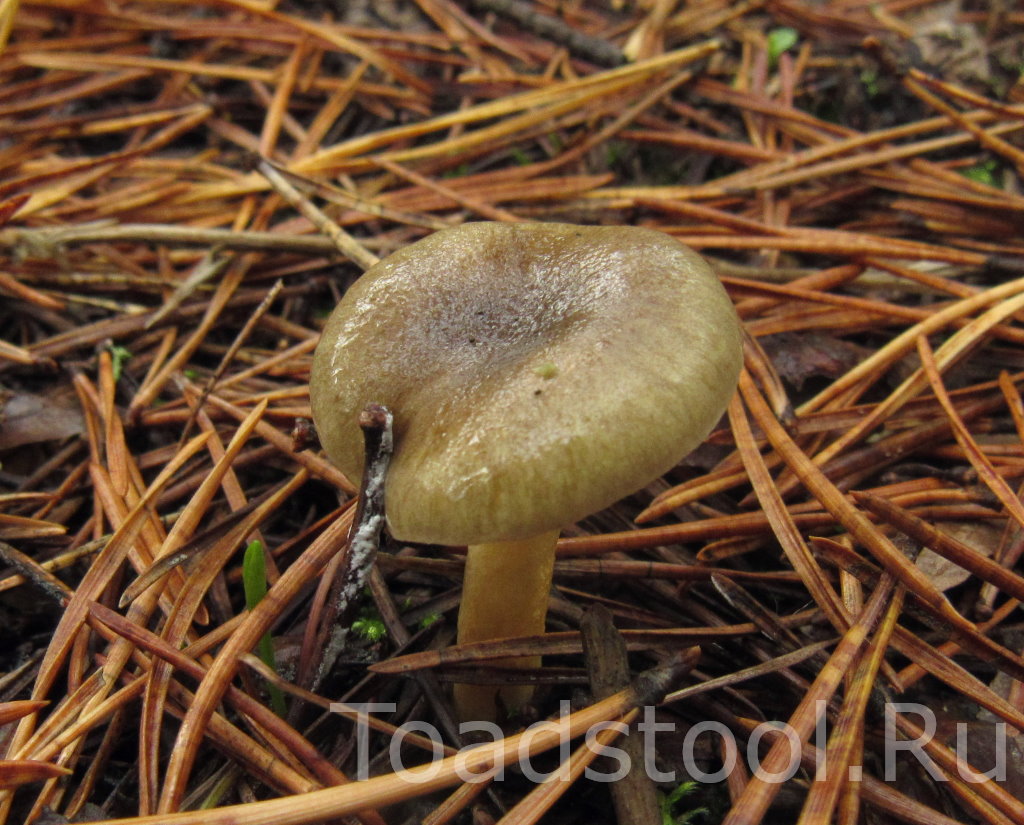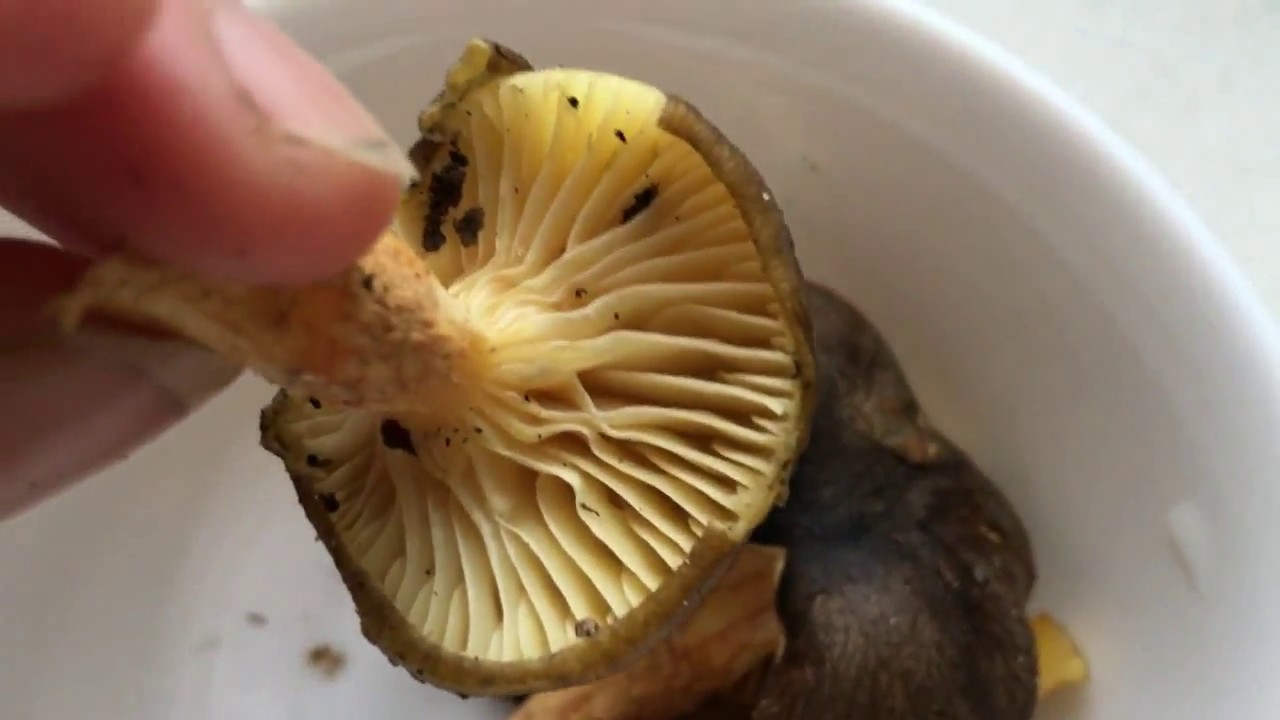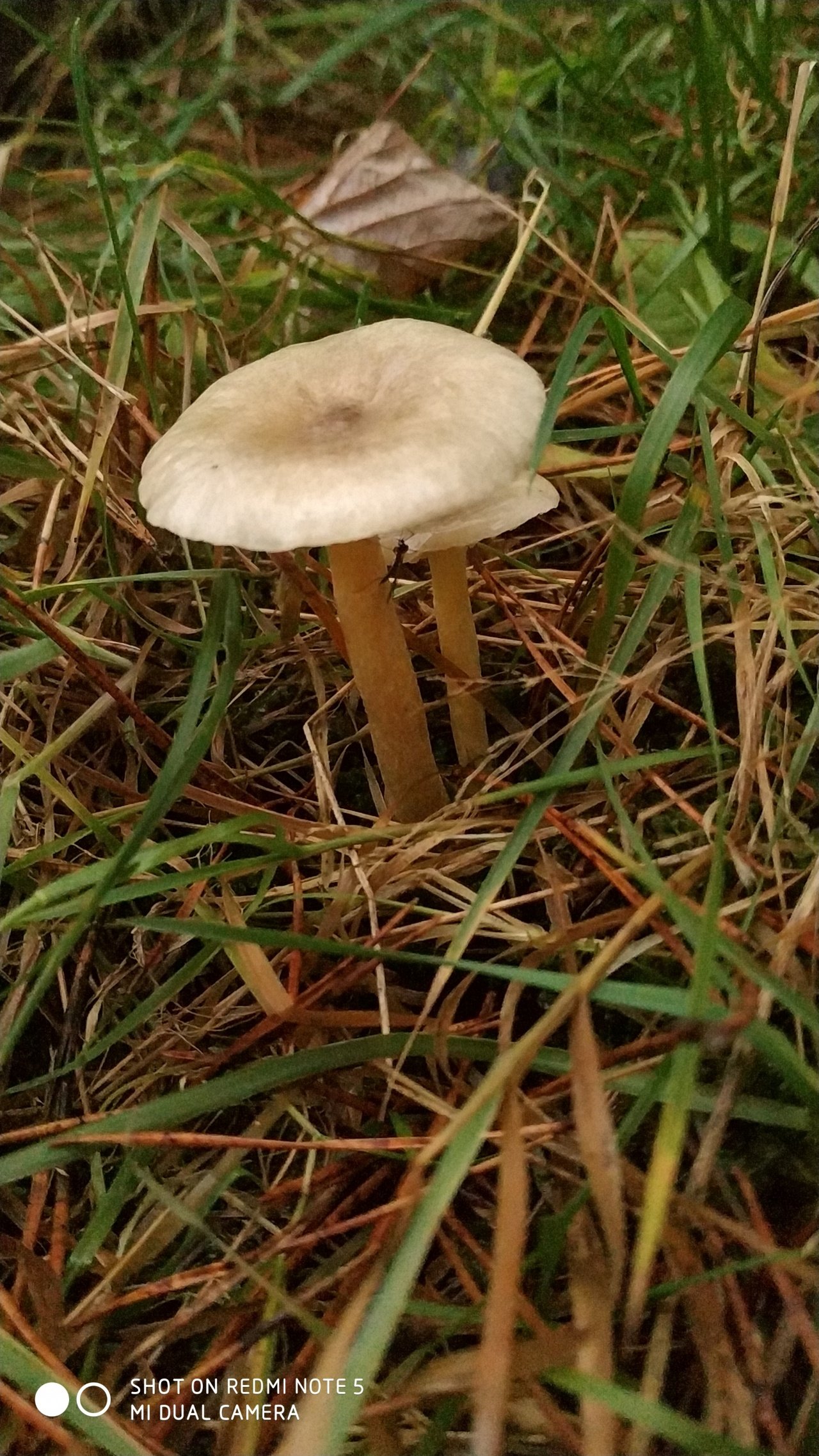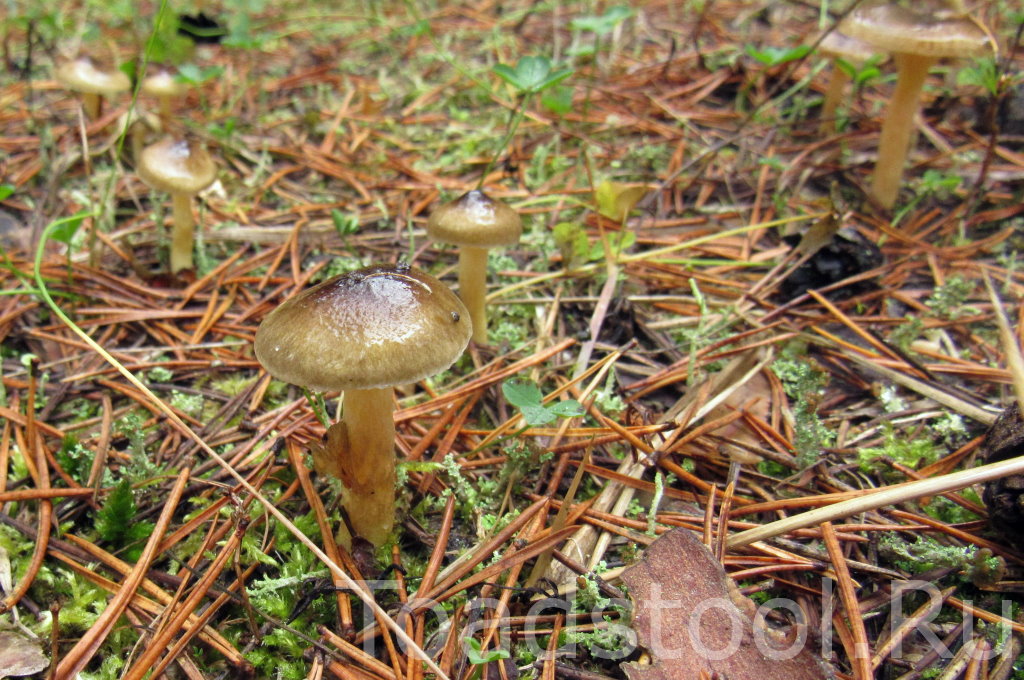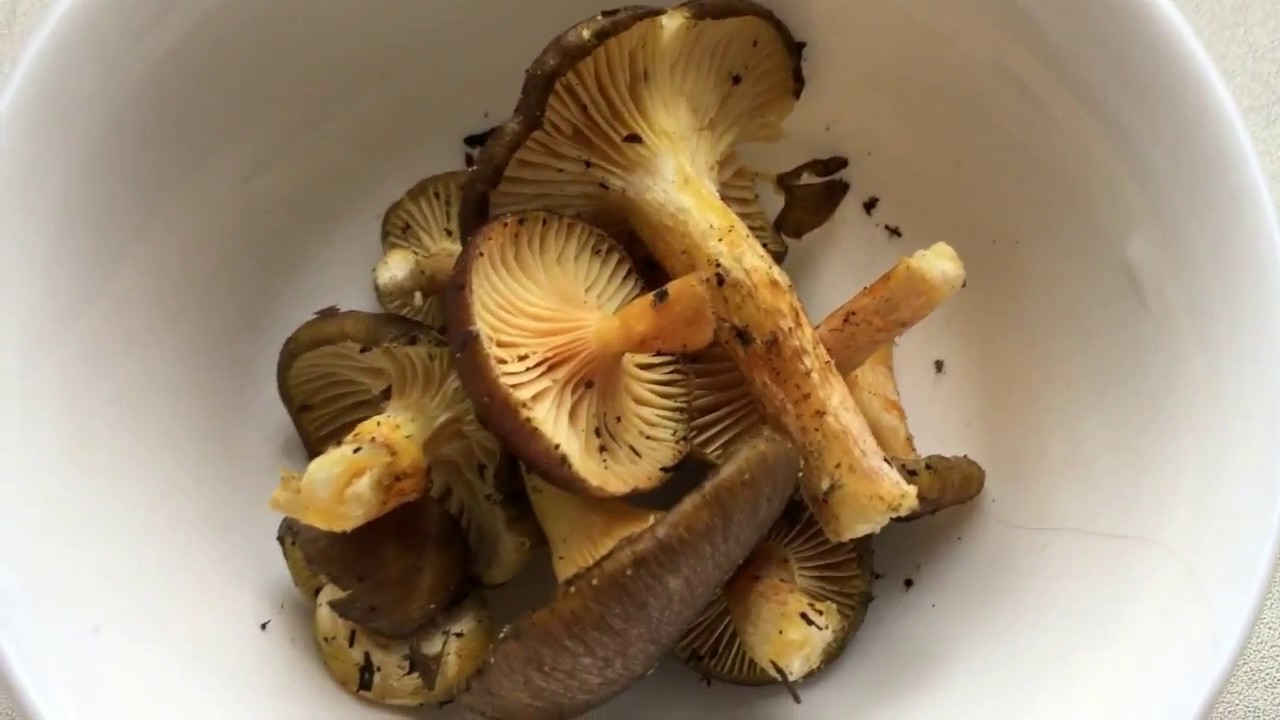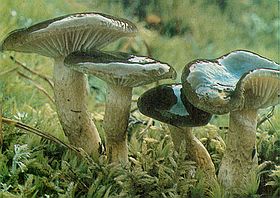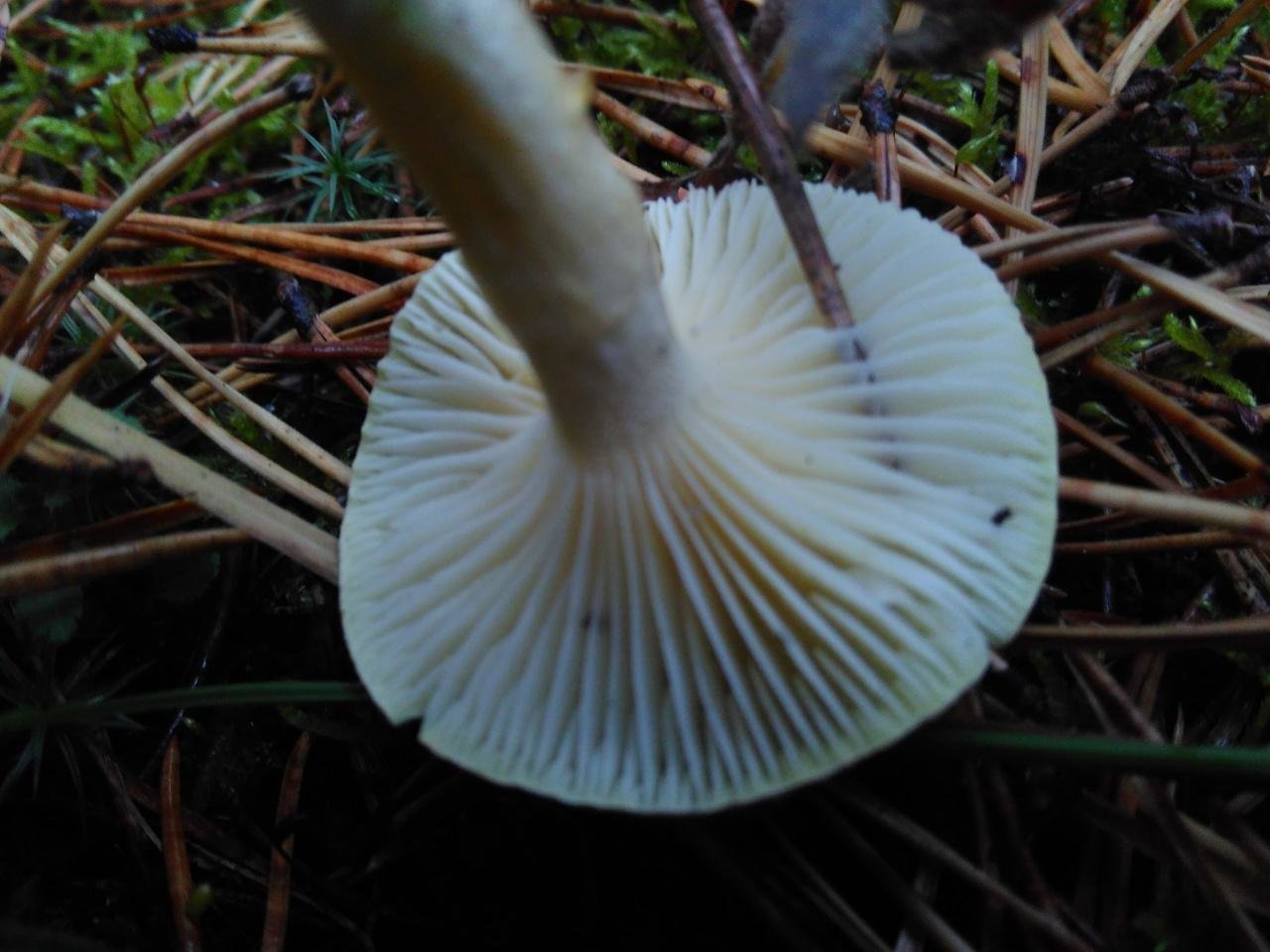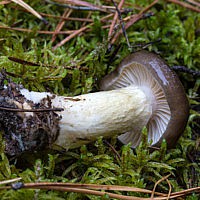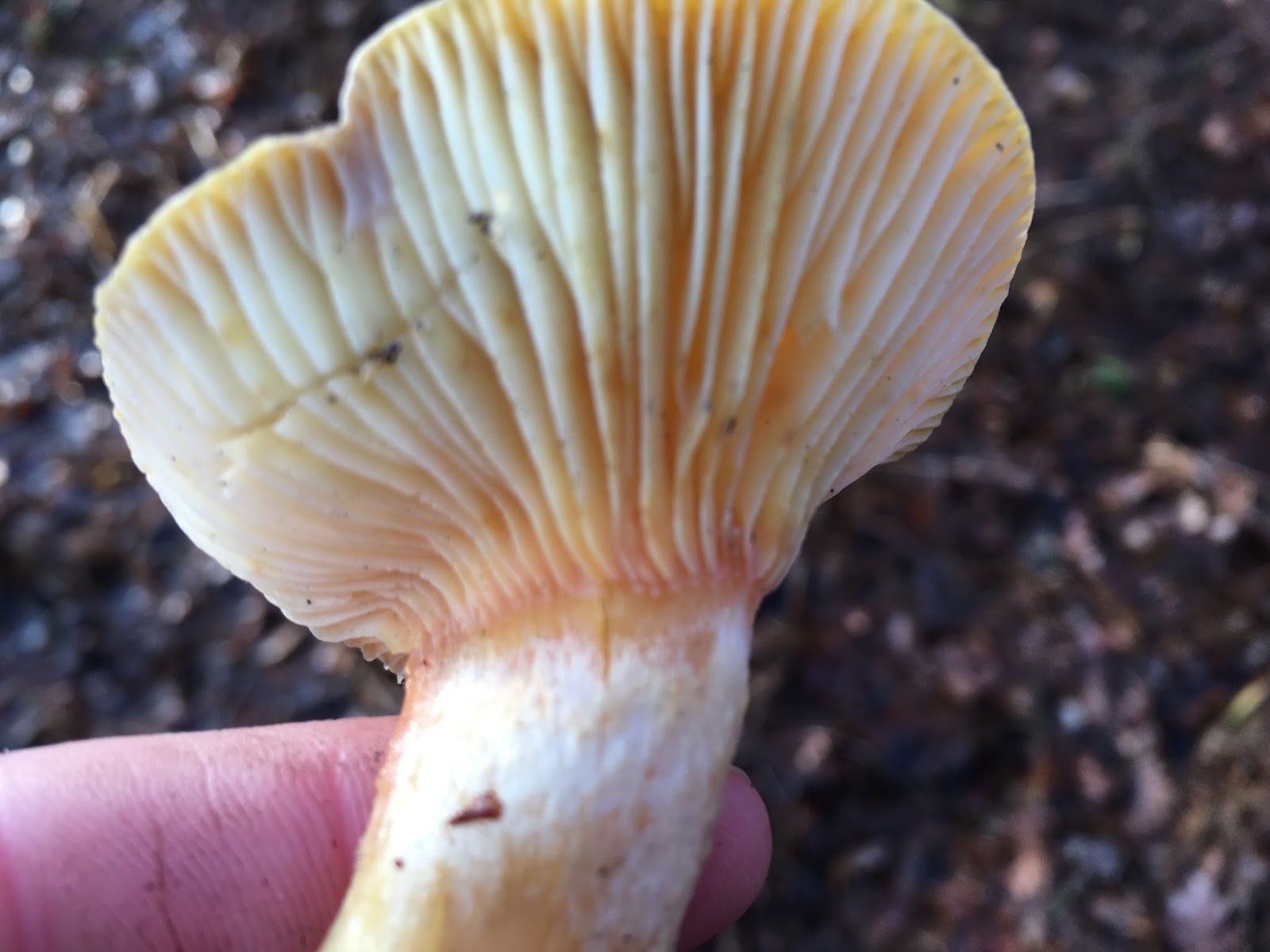Description of the brown hygrophor
The diameter of the brown hygrophor's cap is 2-5 centimeters. The shape of the cap is initially slightly convex or flat with curled edges, but as it grows, the shape becomes funnel-shaped, with a characteristic small tubercle in the center. The color of the hat is yellow-brown, often with an olive tint, especially this shade is inherent in young, moist specimens. The surface of the cap is smooth, very slimy.

The pulp is whitish in color, without a pronounced taste and smell. Fork-shaped plates, rather rare, yellowish, deeply descending along the stem. Spore white powder. The sweetheart's leg is long and thin - its height is 4-10 centimeters, and its diameter is 0.5-1 centimeters. The shape of the leg is cylindrical, often sinuous. The structure of the leg is one-piece. The surface of the leg is more or less slimy, and the color is yellowish.
Distribution of brown hygrophors
These mushrooms bear fruit from mid-September and are found until late autumn, without fear of frost and even the first snow.
Brown hygrophors grow in mixed and coniferous forests. They are found in the vicinity of pine trees. Often they settle among the moss, while hiding up to the very hat. Under good conditions, brown hygrophors can bear fruit in large groups.
Mushroom Gigrofor description.
The name Hygrophorum unites the numerous genus of lamellar mushrooms that are part of the Hygrophoric family. Mushrooms are widespread almost all over the world, but not everywhere they are considered edible. In our latitudes, about 10 different species grow, among which, both edible and inedible. The peculiarity of the genus hygrophor lies in the fact that practically all varieties have small fruit bodies, with convex mucous caps. Consider the descriptions of edible species.
- Snow-white hygrophor.
Tiny mushrooms that are common in meadows and deciduous forest areas. Due to their small size, it is difficult to notice them, so only the most attentive mushroom pickers get the "catch". The cap of the snow-white hygrophor is small, reaching a maximum of 3 cm in diameter. In young mushrooms, the cap has a hemispherical, convex shape, but with age it becomes noticeably flattened, it can become funnel-shaped. In young mushrooms, the color of the cap is white; with age, it acquires a cream or beige shade.
At high humidity, the surface of the caps becomes slimy. A distinctive feature is thin and rare descending plates. The leg grows in height from 3 to 6 cm. The leg is painted in the same shade as the cap. In the context, the pulp is snow-white, with a mild aroma and very thin, almost tasteless. Snow-white gigrofor belongs to the fourth category of edible mushrooms, it can be consumed only after soaking and heat treatment.
- Russula hygrophor.
Another edible variety of the genus Hygrophor. Most often, this mushroom can be found in coniferous forests, birch groves, but not earlier than mid-September, and not later than the end of November. The russula hygrophor has a rich taste and light mushroom aroma, its flesh is white, does not change color during oxidation, but is slightly bitter, so it is soaked before cooking to get rid of the bitter aftertaste.
Pinkish caps can grow from 2 to 9-10 cm, have a hemispherical, convex shape, but eventually become flat, outstretched. On the surface of the cap, small scales are observed closer to the center. The leg is thin, erect or curved, up to 10 cm in height, closer to the cap it is covered with small scales, and at the base it is painted beige. The plates of the mushroom are thick, descending to the stem.
- Gigrofor brown.
This mushroom must be found in damp, parietal and mossy places of coniferous and mixed forests, and it is considered one of the latest, since it begins to bear fruit only at the beginning of October. Mushroom caps are depressed in the center, medium-sized - maximum about 5-6 cm in diameter. The surface of the cap is covered with a thin, sticky, brown, or brown-olive skin, which is slightly lighter at the edges.
Thick, waxy plates are yellow, descend to the peduncle and are sparsely located. Legs are thin, up to 1 cm in diameter, long - up to 10 cm, cylindrical. The leg can be painted in a beige or olive-brown shade, slimy, with a barely noticeable filmy ring - the remains of the bedspread. Brown hygrophor is good for pickling and pickling, can be used boiled.
- Olive brown hygrophor.
An edible and tasty hygrophor, found primarily in coniferous forests. The fruiting season begins in August and ends with the first frost. The legs of this mushroom are white or brown or light olive, covered with ringed scales of a darker shade. Caps can grow up to 10 cm in diameter, slimy and sticky, in dry weather they shine with a glossy shine. The color of the hat is light olive, the shade becomes more saturated closer to the center, and lighter at the edges.
Spotted hygrophorus (Hygrophorus pustulatus)
Other names:
Spotted hygrophoric cap:
2-5 cm in diameter, in young mushrooms it is convex, later prostrate, usually with a tucked edge, slightly concave in the center. The surface of the grayish cap (lighter at the edges than in the center) is densely covered with small scales. In wet weather, the surface of the cap becomes slimy, the scales are not so noticeable, which can make the mushroom as a whole look lighter. The flesh of the cap is white, thin, fragile, without any special smell or taste.
Plates:
Rare, deeply descending on the peduncle, white.
Spore powder:
White.
Spotted hygrophoric stem:
Height - 4-8 cm, thickness - about 0.5 cm, white, covered with noticeable dark scales, which in itself is a good distinguishing feature of the spotted hygrophor. The flesh of the leg is fibrous, not as fragile as in the cap.
Spreading:
Gigroforus spotted occurs from mid-September to late October in coniferous or mixed forests, forming mycorrhiza with spruce; in good seasons it bears fruit in very large groups, although the general inconspicuousness does not allow this worthy hygrophor to gain fame.
Similar species:
Wrong formulation of the question. There are a lot of hygrophors, similar to each other, like two drops of water. The value of Hygrophorus pustulatus is that it is different. In particular, noticeable pimply scales on the stem and cap, as well as large-scale fruiting.
Edible: Edible, like the vast majority of hygrophors; however, it is difficult to say exactly how much. It is considered a little-known edible mushroom with a delicate sweetish taste; it is used fresh (boiling for about 5 minutes), in soups and main dishes.
Remarks
The hygrophors themselves are very interesting mushrooms, with their own inner meaning. Just like Lao Tzu said that a noble man should be like a crooked dry tree growing the devil knows where (so that no one cares about him), so hygrophors are small nondescript mushrooms growing on poor soils, forming mycorrhiza with poor grasses and timid trees, they do not pretend to anything special, but they stand firmly on their feet. The same spotted hygrophor, for example, could compete in popularity with some kind of honey fungus and chanterelle. However, he does not argue. He doesn't need to be collected. He lives in harmony with his surroundings, somehow avoiding greedy human attention, and not even hiding (hiding, as we know from the example of a truffle, does not help either), but just somehow. True Tao cannot be expressed in words, but it can be expressed by mushrooms. It's all.
Types of mushroom hygrophor
Fragrant, aromatic, or fragrant hygrophorus (Hygrophorus agathosmus)
An edible mushroom with a fleshy fruiting body.The hat is 4-8 cm in diameter, convex in shape, gradually becomes flat-convex, the edge is tucked up, the surface is sticky and slimy, especially at high humidity. The color of the cap is gray, yellowish brown or off-white, rarely with a green tint. The plates are rare, grow to the stem, white. The flesh is whitish or pale gray in color, soft, with a strong aroma reminiscent of bitter almonds, celery or anise, and a bland taste. The length of the leg is 4-10 cm, the thickness is 0.6-1.5 cm. The leg is central, cylindrical, dry or wet, the surface is not mucous. The color of the leg is white, gradually turning gray. Spores are white.
Grows from August to September in coniferous and mixed forests. Widespread in temperate climates.
Hygrophorus yellowish white (Hygrophorus eburneus)
Edible mushroom, also known as ivory wax bonnet and cowboy handkerchief. Found in Europe, North America, North Africa.
The fruit body is white. In wet weather, the hat becomes covered with a thick layer of mucus. Feels like wax.
Early hygrophorus (Hygrophorus marzuolus)
A rare species, which is also found under the names of the hygrophor of March and snow mushroom. The diameter of the cap is 4-10 cm, the structure is thick, fleshy, the shape of the young mushroom is convex, flattens with age. The surface is curved, the edges are wavy. The skin is smooth, dry, slightly pubescent. In young mushrooms, the cap is light gray or whitish, in mature ones it is lead-gray or blackish with spots. The pulp is dense, white, turns gray with age. The aroma is weak, pleasant, the taste is not expressed. The leg is 3-8 cm long, 1.5-4 cm wide, cylindrical, curved, solid, thinning downwards. The color is whitish or gray, with a silvery tint. Spores are white.
Unlike other hygrophors, the species is very early, appears in March and grows until the beginning of May. It is found in coniferous and deciduous forests, often under beeches.
An edible mushroom used in soups and garnishes for meat dishes. Since the March hygrophor appears very early, it cannot be confused with other mushrooms, including poisonous ones.
Hygrophorus olive-white (Hygrophorus olivaceoalbus)
The diameter of the cap is 2-6 cm, the shape is hemispherical in young mushrooms, in old ones it is convex or flat, covered with a layer of mucus. The color of the cap is gray-brown or olive-brown, darker in the center, becomes lighter as it matures. The pulp is strong, white, yellow in the center, the pulp is fibrous in the stem. Aroma and taste are poorly expressed. The stem is 4-8.5 cm long and 0.4-1.0 cm thick, central, cylindrical or fusiform, olive-brown color. Spores are white.
An edible mushroom that is eaten fresh.
It grows from August to November in coniferous and mixed forests next to spruce. Widely distributed in Eurasia.
Gigrofor russula or russula (Hygrophorus russula)
A fleshy edible mushroom that grows in the deciduous forests of the Northern Hemisphere.
The diameter of the cap is 5-12 cm, the shape is hemispherical, gradually becoming convex, flattened, the edge is turned up. The surface is smooth, in wet weather it becomes sticky-mucous, in young mushrooms it is whitish or pinkish in color, with pink spots, then it becomes pink-red and in a mature mushroom - wine-red. The pulp is dense, white, pinkish on the cut, the smell is weak, flour, the taste is not pronounced. The leg is 6-8 cm long, 1-2.5 cm thick, central, tapering downward, clavate or fusiform, white with pinkish-brown spots. Spores are white.
Edible mushroom, used fresh, pickled or salted. It is considered the best in taste of all species of the family.
It grows from August to November in deciduous and mixed forests, next to an oak tree.
What mushrooms can be confused with hygrophorus hypothejus and how to distinguish
There are not very many similar species in the sweet-sweet mushroom. But some representatives of this genus still have some common features. To distinguish between them, you need to take a closer look at each individual instance.
Gigrofor white-olive
This fruit is much like a wood lice mushroom, but it has one big difference. The leg of this fruit is striped, which is not typical for wood lice. It is for this pattern that the olive-white hygrophor is distinguished from the brown one.

Leafy hygrophor
It is difficult to confuse this mushroom with a sweet tooth, since they have different colors. But a person who does not know about this, of course, can make a mistake. Deciduous hygrophor is distinguished by a yellow cap shade. Different fruits and symbiote trees. So, woodlouse forms mycorrhiza with pines, and deciduous hygrophoric - with larch. For this he got his name.

False mushroom
It is only at first glance that the false foaming and the late hygrophor are similar to each other. The difference becomes apparent when you turn both fruits over and look under the cap.
The plates of the hymenophore in false fungus are frequent and thin. They seem to have grown to the stem, while in the hygrophor they are rare, large and descend along the stem.

The period of fruiting also differs in mushrooms. Sulfur-yellow false froth grows from June to October. Prefers mountainous terrain and rotten stumps. These features are not typical for the hygrophor.
Gigrofor golden edibility, where it grows, what it looks like, collection rules, photo
Gigrofor golden: is it possible to eat, description and photo
Golden Gigrofor is a lamellar mushroom of the Gigroforov family. This species grows in small groups, forming mycorrhiza with different trees. In other sources, it can be found under the name of the golden-toothed hygrophor. In scientific circles, it is listed as Hygrophorus chrysodon.
What does the golden hygrophor look like?
The fruiting body of this species is of the classical type. The hat initially has a convex bell-shaped shape with an edge concave downward. As it ripens, it straightens out, but a small tubercle remains in the center. The surface is smooth, sticky, covered with thin scales closer to the edge. In young specimens, the color of the upper part is whitish, but later it becomes golden yellow. The diameter of the cap reaches from 2 to 6 cm.
The pulp is watery, soft. It is characterized by a light shade and does not change when cut. The smell is mild, neutral.
On the reverse side of the cap there are rare wide plates descending to the pedicle. The hymenophore initially has a whitish tint, and then becomes yellow. The golden hygrophor has white elliptical spores with a smooth surface. Their size is 7.5-11 x 3.5-4.5 microns.
The leg is cylindrical, narrowed at the base, sometimes slightly curved. Its length reaches 5-6 cm, and its width is 1-2 cm. In young fruits, it is dense, and then a cavity appears. The surface is sticky, white, with a light fluff closer to the cap and yellow scales along the entire length.
Where does the golden hygrophor grow
This mushroom is common, but it grows singly or in small groups. Prefers conifers and deciduous forests with humus-rich soil. Forms mycorrhiza with oak, linden, pine. The fruiting period begins in mid-August and continues through the second decade of October inclusive.
The golden hygrophor is widespread in Europe and North America. On the territory of Russia, it is found everywhere.
Is it possible to eat a golden hygrophor
This mushroom is considered edible. But it does not possess high taste, therefore it belongs to the fourth category.
False doubles
At the initial stage of development, the gigrofor is golden in many ways similar to its relatives. Therefore, in order to avoid error, it is necessary to study the characteristic differences of twins.
- Fragrant gigrofor. It has a pronounced almond scent, and in rainy weather it can spread for several meters around. You can also distinguish it by the gray-yellow shade of the hat. This mushroom is considered conditionally edible and is characterized by a sweetish pulp taste. The official name is Hygrophorus agathosmus.
- Gigrofor is yellowish-white. The fruiting body is medium in size. The main color is white. A distinctive feature is that when rubbed, wax is felt on the fingers.The mushroom is edible, its official name is Hygrophorus eburneus.
Collection rules and use
Mushroom picking should be done with a sharp knife, cutting off the fruiting body at the base. This will prevent damage to the mycelium.
Before use, forest fruits must be cleaned of litter and soil particles. Then rinse the mushrooms thoroughly. It can be consumed fresh and processed.
Conclusion
Gigrofor golden belongs to the category of unpopular, but edible mushrooms. This is due to its poor fruiting, which makes harvesting difficult, and its neutral taste. Therefore, most mushroom pickers bypass it. Since during the fruiting period, more valuable species can be harvested.
Description of the late hygrophor
Late hygrophoros - representative of the department of Basidiomycetes, class Agaricomycetes. Belongs to the Gigroforov family and the Gigrofor genus. According to its taste and nutritional value, it is considered a conditionally edible mushroom.

What does it look like
Gigrofor does not have a specific appearance, therefore it is often confused with other mushroom breeds. It looks a bit like a honey agaric, and when the weather is wet and its skin becomes covered with mucus, it becomes similar to an oil can. In the shape of the cap, the depression in its center and the arrangement of the plates, it vaguely resembles a saffron milk cap.
The structure and features of the species
The structural features of the woodlice mushroom are as follows:
- Hat. It is quite miniature, its diameter is only 3-5 centimeters. In young mushrooms, its shape is flat or slightly convex. The edges of the cap are noticeably tucked up. As it matures, the cap part of the hygrophor becomes funnel-shaped. A characteristic tubercle forms in the center. In color, this part of the fruiting body is not too bright. Usually his color is yellow-brown with olive tint.
- Leg. It grows up to 5-10 centimeters in height and up to 0.5-1 cm in diameter. Its shape is cylindrical, and it itself is solid, but sometimes it is winding. The surface of the leg is smooth. In older specimens, a cavity may form inside it. On the stem of a young mushroom, there are remnants of a blanket in the form of a ring. But over time, it completely disappears. The color of the leg is yellowish, or it may not differ at all from the color of the cap.
- Pulp. Very soft and fragile to the touch. In the cap part, it is almost completely white, but in the stem it becomes yellowish. The pulp has neither a characteristic taste nor a pronounced smell.
- The hymenophore is lamellar. The plates are sparsely located, their structure is dense, thick, waxy. The plates descend from the cap to the stem. Their color ranges from white to yellowish, but rarely pink.
The spore powder of the hygrophor is white.
The sweet mushroom is a little-known conditionally edible fruit. But ignoring it is completely in vain, since it has excellent taste.




